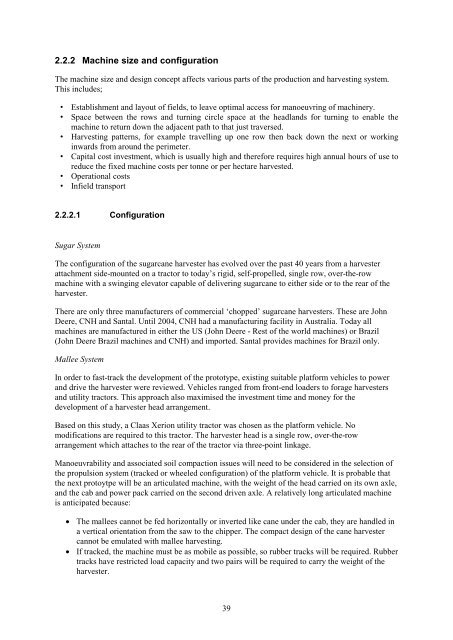Download (4Mb) - USQ ePrints - University of Southern Queensland
Download (4Mb) - USQ ePrints - University of Southern Queensland
Download (4Mb) - USQ ePrints - University of Southern Queensland
You also want an ePaper? Increase the reach of your titles
YUMPU automatically turns print PDFs into web optimized ePapers that Google loves.
2.2.2 Machine size and configuration<br />
The machine size and design concept affects various parts <strong>of</strong> the production and harvesting system.<br />
This includes;<br />
• Establishment and layout <strong>of</strong> fields, to leave optimal access for manoeuvring <strong>of</strong> machinery.<br />
• Space between the rows and turning circle space at the headlands for turning to enable the<br />
machine to return down the adjacent path to that just traversed.<br />
• Harvesting patterns, for example travelling up one row then back down the next or working<br />
inwards from around the perimeter.<br />
• Capital cost investment, which is usually high and therefore requires high annual hours <strong>of</strong> use to<br />
reduce the fixed machine costs per tonne or per hectare harvested.<br />
• Operational costs<br />
• Infield transport<br />
2.2.2.1 Configuration<br />
Sugar System<br />
The configuration <strong>of</strong> the sugarcane harvester has evolved over the past 40 years from a harvester<br />
attachment side-mounted on a tractor to today’s rigid, self-propelled, single row, over-the-row<br />
machine with a swinging elevator capable <strong>of</strong> delivering sugarcane to either side or to the rear <strong>of</strong> the<br />
harvester.<br />
There are only three manufacturers <strong>of</strong> commercial ‘chopped’ sugarcane harvesters. These are John<br />
Deere, CNH and Santal. Until 2004, CNH had a manufacturing facility in Australia. Today all<br />
machines are manufactured in either the US (John Deere - Rest <strong>of</strong> the world machines) or Brazil<br />
(John Deere Brazil machines and CNH) and imported. Santal provides machines for Brazil only.<br />
Mallee System<br />
In order to fast-track the development <strong>of</strong> the prototype, existing suitable platform vehicles to power<br />
and drive the harvester were reviewed. Vehicles ranged from front-end loaders to forage harvesters<br />
and utility tractors. This approach also maximised the investment time and money for the<br />
development <strong>of</strong> a harvester head arrangement.<br />
Based on this study, a Claas Xerion utility tractor was chosen as the platform vehicle. No<br />
modifications are required to this tractor. The harvester head is a single row, over-the-row<br />
arrangement which attaches to the rear <strong>of</strong> the tractor via three-point linkage.<br />
Manoeuvrability and associated soil compaction issues will need to be considered in the selection <strong>of</strong><br />
the propulsion system (tracked or wheeled configuration) <strong>of</strong> the platform vehicle. It is probable that<br />
the next protoytpe will be an articulated machine, with the weight <strong>of</strong> the head carried on its own axle,<br />
and the cab and power pack carried on the second driven axle. A relatively long articulated machine<br />
is anticipated because:<br />
• The mallees cannot be fed horizontally or inverted like cane under the cab, they are handled in<br />
a vertical orientation from the saw to the chipper. The compact design <strong>of</strong> the cane harvester<br />
cannot be emulated with mallee harvesting.<br />
• If tracked, the machine must be as mobile as possible, so rubber tracks will be required. Rubber<br />
tracks have restricted load capacity and two pairs will be required to carry the weight <strong>of</strong> the<br />
harvester.<br />
39
















